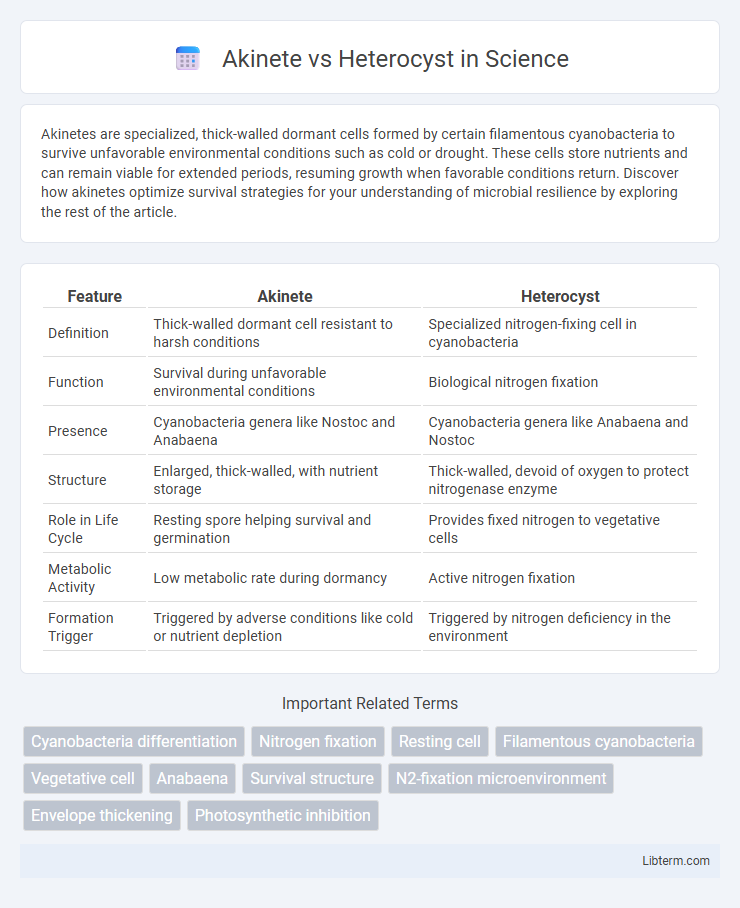Akinetes are specialized, thick-walled dormant cells formed by certain filamentous cyanobacteria to survive unfavorable environmental conditions such as cold or drought. These cells store nutrients and can remain viable for extended periods, resuming growth when favorable conditions return. Discover how akinetes optimize survival strategies for your understanding of microbial resilience by exploring the rest of the article.
Table of Comparison
| Feature | Akinete | Heterocyst |
|---|---|---|
| Definition | Thick-walled dormant cell resistant to harsh conditions | Specialized nitrogen-fixing cell in cyanobacteria |
| Function | Survival during unfavorable environmental conditions | Biological nitrogen fixation |
| Presence | Cyanobacteria genera like Nostoc and Anabaena | Cyanobacteria genera like Anabaena and Nostoc |
| Structure | Enlarged, thick-walled, with nutrient storage | Thick-walled, devoid of oxygen to protect nitrogenase enzyme |
| Role in Life Cycle | Resting spore helping survival and germination | Provides fixed nitrogen to vegetative cells |
| Metabolic Activity | Low metabolic rate during dormancy | Active nitrogen fixation |
| Formation Trigger | Triggered by adverse conditions like cold or nutrient depletion | Triggered by nitrogen deficiency in the environment |
Introduction to Akinetes and Heterocysts
Akinetes and heterocysts are specialized cells found in cyanobacteria that support survival and nitrogen fixation, respectively. Akinetes are thick-walled dormant cells that enable cyanobacteria to withstand harsh environmental conditions, while heterocysts are differentiated cells dedicated to nitrogen fixation under anaerobic conditions. Both cell types play crucial roles in the life cycle and ecological adaptability of filamentous cyanobacteria like Anabaena and Nostoc species.
Definitions and Basic Characteristics
Akinetes are thick-walled dormant cells formed by certain cyanobacteria to survive adverse environmental conditions such as cold or nutrient depletion. Heterocysts are specialized nitrogen-fixing cells with thick walls that provide an anaerobic environment essential for nitrogenase enzyme activity in filamentous cyanobacteria. Both cell types differ fundamentally in function: akinetes serve as survival structures, while heterocysts facilitate nitrogen fixation under nitrogen-limited conditions.
Structural Differences
Akinetes are thick-walled, dormant cells that serve as survival structures in cyanobacteria, characterized by their dense cytoplasm and large size compared to vegetative cells. Heterocysts are specialized nitrogen-fixing cells with thickened cell walls to create a micro-oxic environment necessary for nitrogenase activity. Structurally, akinetes lack the specialized envelope layers present in heterocysts and are primarily adapted for resistance to environmental stress, while heterocysts possess unique glycolipid and polysaccharide layers to limit oxygen diffusion.
Functions and Biological Roles
Akinetes serve as resistant spores in cyanobacteria, enabling survival under harsh environmental conditions by storing nutrients and protecting cellular components. Heterocysts function as specialized nitrogen-fixing cells, providing an anaerobic environment crucial for converting atmospheric nitrogen into ammonia. Both structures play vital roles in cyanobacterial adaptation, with akinetes ensuring longevity during stress and heterocysts supporting growth in nitrogen-poor habitats.
Formation and Development Processes
Akinetes form through the thickening of cell walls and accumulation of storage compounds under environmental stress, enabling cyanobacteria to survive unfavorable conditions. Heterocysts develop from vegetative cells by differentiating into specialized nitrogen-fixing cells with thickened walls to maintain anaerobic conditions essential for nitrogenase activity. Both processes involve gene regulation and cellular differentiation but serve distinct survival and metabolic functions within cyanobacterial filaments.
Environmental Triggers and Adaptations
Akinetes form in cyanobacteria as dormant cells triggered by adverse environmental conditions such as cold temperatures and nutrient depletion, allowing survival through extended periods of stress. Heterocysts develop in filamentous cyanobacteria in response to nitrogen scarcity, specializing in oxygen-resistant nitrogen fixation to support growth in nitrogen-poor environments. Both structures represent adaptive strategies that enhance cyanobacterial resilience and ecological success under fluctuating environmental pressures.
Cellular Composition and Morphology
Akinetes are thick-walled dormant cells in cyanobacteria characterized by their large size and dense cytoplasmic inclusions such as cyanophycin and glycogen, which provide energy reserves during unfavorable conditions. Heterocysts, specialized nitrogen-fixing cells, display a distinctly thickened envelope composed of a glycolipid layer and polysaccharide layer, enabling a microoxic environment essential for nitrogenase activity. Morphologically, akinetes appear as swollen, oval cells embedded within filaments, whereas heterocysts are typically barrel-shaped, larger than vegetative cells, and positioned at regular intervals along the filament.
Importance in Cyanobacterial Life Cycles
Akinetes serve as dormant spores that ensure survival of cyanobacteria under unfavorable environmental conditions by resisting desiccation and nutrient scarcity. Heterocysts specialize in nitrogen fixation, providing essential biologically available nitrogen to the cyanobacterial community when external sources are limited. Together, akinetes and heterocysts play crucial roles in sustaining cyanobacterial populations, with akinetes enabling long-term persistence and heterocysts facilitating growth and metabolic balance.
Ecological Significance
Akinetes serve as resistant spores in cyanobacteria, enabling survival under harsh environmental conditions such as cold or nutrient scarcity, thus ensuring species persistence. Heterocysts specialize in nitrogen fixation, converting atmospheric nitrogen into bioavailable forms, which significantly enhances soil fertility and supports ecosystem productivity. Together, akinetes and heterocysts play crucial roles in maintaining cyanobacterial populations and sustaining nutrient cycles in aquatic and terrestrial ecosystems.
Key Differences Summarized
Akinetes are thick-walled dormant cells in cyanobacteria that provide resistance to harsh environmental conditions, primarily serving as survival structures. Heterocysts are specialized nitrogen-fixing cells with thick walls that protect nitrogenase from oxygen, enabling nitrogen fixation under aerobic conditions. Unlike akinetes, which are primarily for dormancy, heterocysts actively participate in nitrogen metabolism within the filament.
Akinete Infographic

 libterm.com
libterm.com